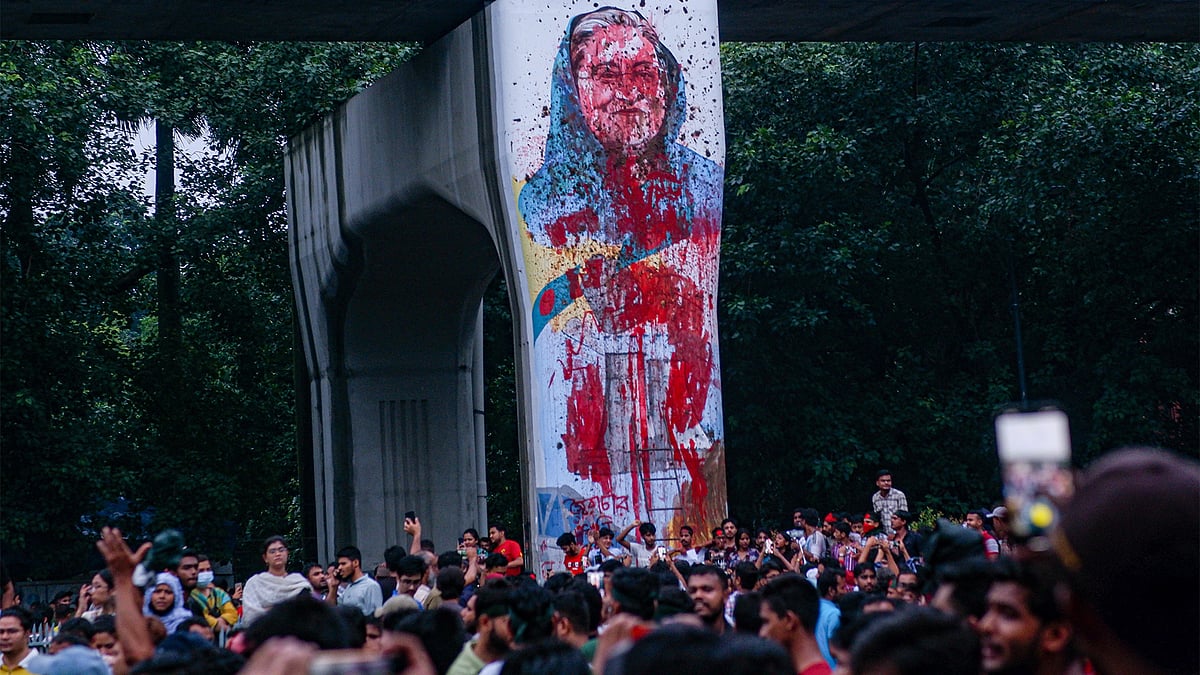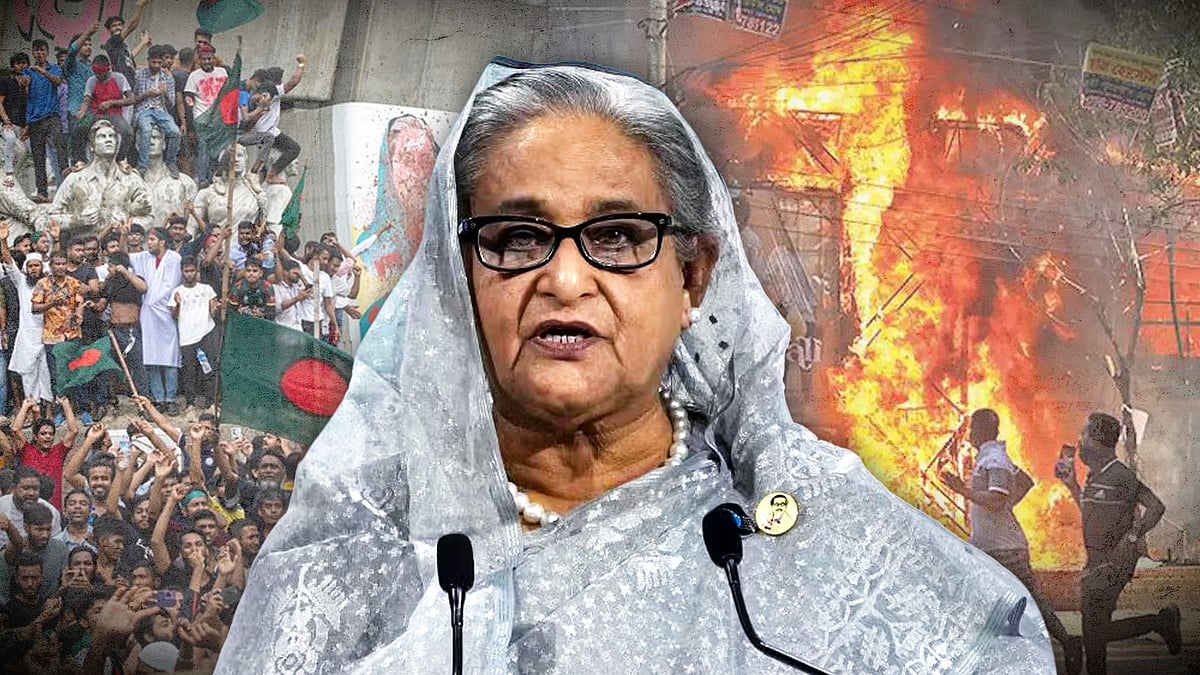‘Report with facts, would be better for us’: Hindu students in Bangladesh on Indian media coverage
Sections of the Indian media have sensationalised the violence and discredited the role played by students in the movement against Hasina.
“If the Indian media had done its job properly, we would’ve had an easier time talking about what we are facing,” said Bipra Prasun Das, a 21-year-old Hindu student from North South University in Dhaka, whose ancestral home was burnt down in violence in Bangladesh this week.
Das had actively participated in the student protests that led to Sheikh Hasina’s resignation as the Bangladesh prime minister. But his sense of joy turned to distress as reports of large-scale vandalism and violence, including attacks on Hindu homes, shops and places of worship, emerged on August 5. “We are really scared; my own ancestral home was burned down. We do not know who is behind these attacks, but they are happening all over Bangladesh.”
Hindus constitute about 8 percent of Bangladesh’s 170 million people. While the scale of the attacks on the minority remains unclear, external affairs minister S Jaishankar had earlier told parliament that he was “deeply concerned” about the safety of Bangladeshi Hindus. Some reports in the Bangladeshi media had pointed to attacks on Hindu properties and places of worship in 27 districts. Close to 232 people have been killed across Bangladesh since Monday, taking the toll to 560 since the anti-quota protests first started in mid-July.
There have been calls for action by sections of the Hindu right wing in India, and some, including BJP’s Suvendu Adhikari, have pointed to the possibility of a large-scale immigration amid what they see as widespread violence due to a complete takeover of the neighbouring country by “Islamists”.
To understand the current situation on the ground in Bangladesh and the movement that reshaped the country’s political landscape, Newslaundry spoke to Hindu students over the phone. While all the students confirmed the attacks on minorities, they also pointed to misinformation around the violence, including the role played by Indian media.
Many prominent Indian anchors have rejected the idea that the protests had been led by students, painting it as engineered by anti-India forces and Islamist groups such as the Jamaat-i-Islami. And in their coverage of the attacks on Hindu minorities, several channels have tried to attack opposition parties in India – one anchor even claimed no one came to stop this “genocide” like how “they did” for Rafah in Gaza.
Das said such coverage has led to “people in Bangladesh saying that reports of attacks on Hindus is ‘fake Indian propaganda’”. “Right now, Indian media needs to report what is happening, factually. They are sensationalising it.”
From CAA to ‘ISI link’
On the day Hasina fled Bangladesh, News18 India anchor Aman Chopra claimed on his show that the student protest had been “hijacked” by the Bangladesh Nationalist Party at the behest of the Jamaat-e-Islami and Pakistan’s secret service ISI.
Republic chief Arnab Goswami on Monday suggested the “American Deep State” was involved, before pointing to another “toolkit” on Tuesday. “This is what Pakistan wanted. The Jamaat-e-Islami, the hardline pro-jihadi group, has been financed by the ISI for years. We all know it and now it’s payback time for the Jamaat-e-Islami.”
Meanwhile, Sushant Sinha of Times Now Navbharat deployed the attacks on Bangladeshi Hindus to slam the opposition parties. “INDI alliance leaders have shed no tears for Hindus…these are the same people who were irked about Modi bringing in CAA. Will you still ask why CAA was brought in?”
Sudhir Chaudhary compared the situation to Gaza on his show on Aaj Tak on Tuesday. “No country, no community in the world stepped forward to stop this genocide. Like how they did for Rafah.”
‘Propaganda’
Student activists, who were part of the movement, recalled how their protests over quota became a mass movement in mid-July when the Hasina government brutally clamped down on students, shooting and killing hundreds of them.
“It was a movement of students till July 14. But when the Hasina government tried to brutally suppress the students, people also became a part of it and it spread to the nook and corner of society,” Mitu Sarkar, who has completed an MBA from the National University of Bangladesh and is the president of the Bangladesh Students Federation, told Newslaundry.
Das held similar views. “Jamaat and BNP only joined in the protest towards the end when they saw that the movement had a legitimate chance to overthrow Hasina,” he said. In fact, when the opposition parties started taking credit for the protests, “we were dumbfounded”.
After Hasina left the country, Bangladesh has been under the control of the army. The police are on indefinite strike as they face public anger over their attempts to crush the protests. And amid reports of violence and attacks on Hindus, a section of students and civil society groups also formed volunteer groups to manage the situation. Mohammad Yunus, the new chief adviser and head of the interim government in Bangladesh, has even threatened to quit. “If you trust me to lead your country, the first step is to cease all attacks on people, especially minorities. Without this, my efforts are futile, and it would be better if I stepped aside,” he said.
A Hindu student from Kushtia in Bangladesh, who wished to remain anonymous, said he saw a house in front of his home attacked by a mob amid religious slogans on August 5. “It’s hard to speculate right now what is the main reason…in some places, it seems communal, in other places it seems either political or personal,” he said. “I have followed Indian media on X and Instagram, not all what they are claiming are true. Many news stories are driven by Hindutva propaganda.”
He said that Bangladeshi Hindus are scared. “People are watching over temples and other properties of minorities at night. Both Hindus and Muslims are doing it together.”
Taposhi Dey Prapti, another student protester from Jahangirnagar University in Dhaka, said Hindus in rural areas were at greater risk since the support groups are smaller and law enforcement agencies “are doing absolutely nothing”. But she claimed the Indian media was putting up a “narrative that without Hasina, Hindus of Bangladesh are totally unsafe”. “This is a wrong narrative. At the moment, as there’s no government, everything is working in a situation of lawlessness and we hope to put an end to it as soon as possible.”
Hindus in Bangladesh are seen as traditional voters of Hasina’s party, and sections of the Indian media have been trying to portray Hasina as a saviour with an unblemished record on the protection of minorities in the Muslim-majority country.
Gaurav Sawant on his show on India Today, completely ignored a Bangladeshi journalist when the latter tried to point out that many Hindus were killed when Hasina was in power. In a show on News 18 India on Monday, Rubika Liyaqat said that Sheikh Hasina “always favours us (India). Hope people don’t vent the anger against her on Hindus and minorities living there”.
But Aishe Sarkar, a 22-year-old student protester from University of Dhaka, pointed to attacks on the community from across the political spectrum, including the Awami League as well as the BNP. “They (Awami League supporters) are trying to prove that without the Awami League and Hasina’s family members of Sheikh Hasina, people of the country can’t live peacefully. Though in reality, in the past 15 years, we have faced continuous attacks during Durga Puja.”
Mitu Sarkar said some interviews in West Bengal media outlets give the impression that the conflict in Bangladesh is purely “communal”. “This kind of publicity by the Indian media is only dangerous for us. It leads to misunderstanding among different communities.”
Meanwhile, several activists claimed that incidents of violence against minorities have declined over the past two days.
Flora Nawshin, a student protester from the University of Dhaka, said minorities always face the brunt of “anarchy”. “But there are volunteer groups coming up organically. Students are taking initiative to organise and help minorities.”
Joyonta Sawon, a former office-bearer of the Bangladesh Students Federation and a National University of Bangladesh alumnus, claimed the attacks were more “political” than communal. “There is a breakdown of law and order here. And there is a lot of anger against the Awami League among people. So, in many cases those who are associated with Awami League are being attacked by people,” Sawon said, saying that Indian media coverage on attacks on minorities has been partly true.
Abdur Nur Tushar, a Muslim protester who studies engineering at the Bangladesh University of Engineering and Technology in Dhaka, said: “In my locality, Tangail, we got information about attacks on three Hindu temples – Korotiya, Gopalpur and Delduar Upzilla. On the ground we found one of the cases is true. When we saw the temple was damaged at Korotiya, we told people that we will collect money and do everything to restore it,” he said.
On the influence of the BNP and Jamaat in the protest, he said if it was possible, it would’ve been visible during the 2018 and 2024 elections.
Complaining about the media is easy. Why not do something to make it better? Support independent media and subscribe to Newslaundry today.
 The slogans, the geopolitics, and the fraught second liberation of Bangladesh
The slogans, the geopolitics, and the fraught second liberation of Bangladesh No happy endings for India on Hasina’s road to exit
No happy endings for India on Hasina’s road to exit